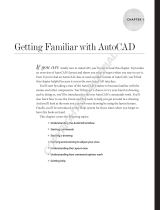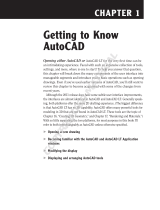Page is loading ...

CHAPTER 1
Getting to Know
AutoCAD
Opening either AutoCAD or AutoCAD LT for the very first time can be an
intimidating experience. Faced with such an expansive collection of tools,
settings, and more, where do you start? To help you answer that question,
this chapter breaks down the many components of the user interface into
manageable segments and introduces you to basic operations such as open-
ing drawings. Even if you’ve used earlier versions of AutoCAD, you’ll still
want to review this chapter to become acquainted with some of the changes
from recent years.
Although the 2012 release does have some subtle user interface improve-
ments, the AutoCAD and AutoCAD LT interfaces are almost identical. Generally
speaking, both platforms offer the same 2D drafting experience. The biggest
difference is that AutoCAD LT has no 3D capability. AutoCAD offers many
powerful tools for modeling in 3D that are not found in AutoCAD LT. (These
tools are the topic of Chapter 16, “Creating 3D Geometry,” and Chapter 17,
“Rendering and Materials.”) With so little separating the two platforms, for
most purposes in this book I’ll refer to both interchangeably as AutoCAD
unless otherwise specified.
Opening a new drawing
Becoming familiar with the AutoCAD and AutoCAD LT Application
windows
Modifying the display
Displaying and arranging AutoCAD tools
016770c01.indd 1 6/20/11 2:12 PM
COPYRIGHTED MATERIAL

2 Chapter1•GettingtoKnowAutoCAD
Starting AutoCAD
If you installed AutoCAD by using the default settings for the location of the
program files, start the program by choosing Start
➢ Programs➢ Autodesk➢
AutoCAD 2012
➢ AutoCAD 2012 or by choosing Start➢ Programs➢ Autodesk➢
AutoCAD LT 2012
➢ AutoCAD LT 2012, depending on your program. (This com-
mand path might vary depending on the Windows operating system and scheme
you are using.) Alternatively, you can find and double-click the AutoCAD 2012
icon or the AutoCAD LT 2012 icon on your desktop.
NOTE
You can also use AutoCAD-based products such as AutoCAD
Architecture or AutoCAD Civil 3D to learn the topics covered in this book. To
use one of these vertical products, choose Start ➢ Programs ➢ Autodesk ➢
AutoCAD Product Name 2012 ➢ AutoCAD Product Name As AutoCAD 2012.
Accessing Autodesk Exchange for AutoCAD
Autodesk Exchange for AutoCAD opens when the application is first launched,
and provides integrated access to the popular AutoCAD Exchange (
http://
autocad.autodesk.com
). Similar to the Welcome screen found in earlier
releases, the Autodesk Exchange window shown in Figure1.1 leads to several
resources including application downloads, help content, videos, and even
community-generated content such as blogs and discussion forums.
The following elements make up the Autodesk Exchange For AutoCAD window:
Home Tab The most prominent component of the Home tab is a feature slider
highlighting the latest tips, tricks, and information related to AutoCAD. As seen
in Figure1.1, below the feature slider are several links to additional resources,
including a list of productivity enhancing Featured Videos and Featured Topics.
On the right edge of the Autodesk Exchange For AutoCAD window are several
links. Starting from the top, you will find direct links to the top-selling AutoCAD
products from the store. Just below are several Important Links to resources
such as Product Support and the Subscription Center.
Help Tab Providing easy access to the AutoCAD help system, the Help tab brings
several learning resources together in one place. Here a long list of resources
including product documentation, product support, blog articles, tips and tricks,
expert responses to questions, and more may be browsed and searched simultane-
ously (see Figure1.2).
016770c01.indd 2 6/20/11 2:12 PM

Starting AutoCAD 3
FIGURE 1.1 The Autodesk Exchange window featuring a collection of AutoCAD resources
FIGURE 1.2 Accessing AutoCAD help documentation
016770c01.indd 3 6/20/11 2:12 PM

4 Chapter1•GettingtoKnowAutoCAD
Along the right edge of the Help tab is a list of additional resources. Among
these resources is a link to a collection of Getting Started Videos. These Getting
Started Videos go beyond the topic of what’s new and instead dig deeper, offer-
ing a more comprehensive look at a complete process (see Figure1.3). Here you
can gain a better understanding of topics such as 3D modeling or even take a
guided tour of the user interface.
FIGURE 1.3 Getting Started Videos as found in the AutoCAD Exchange
For AutoCAD window
After exploring the Autodesk Exchange For AutoCAD window, you may prefer
to disable it from automatically loading each time you start the software. This
can be done by deselecting the check box labeled Show This Window At Start Up
in the lower-left corner of the window. Even after choosing this option, you can
still quickly access the window by using the Exchange button found on the right
end of the AutoCAD title bar.
Understanding the Customer Involvement Program
AutoCAD 2012 is among a large number of Autodesk products that provide the
opportunity to participate in a customer involvement program (CIP). The CIP is
designed to collect nonpersonal information about your Autodesk products and
016770c01.indd 4 6/20/11 2:12 PM

Starting AutoCAD 5
computer system to help the product programmers and developers design soft-
ware that best meets your needs. If you haven’t yet agreed or declined to partici-
pate, the Customer Involvement Program dialog box (Figure1.4) might prompt
you to join when you first start AutoCAD.
FIGURE 1.4 The Autodesk Customer Involvement Program dialog box
Participation is strictly voluntary and, if you choose to participate, AutoCAD
will periodically send a small file to Autodesk containing information such
as your software name and version, the commands you use, and your system
configuration information. An Internet connection is required, and you must
ensure that your firewall settings don’t prevent the information from being
transmitted.
Exploring the AutoCAD User Interface
After you dismiss all of the initial dialog boxes, AutoCAD opens to display its
default user interface, or UI as it’s sometimes called. Collectively known as the
Application window, the user interface can be broken down into numerous
parts. Many of these parts remain unchanged regardless of how the software is
configured, whereas other elements may not always be viewable. I’ll explain how
AutoCAD chooses to configure the user interface shortly. At this point, however,
your graphics window should look similar to Figure1.5.
016770c01.indd 5 6/20/11 2:12 PM

6 Chapter1•GettingtoKnowAutoCAD
Application Menu Quick Access Toolbar
Ribbon tab Ribbon Panel Info Center
Ribbon
View Cube
Navigation Bar
Cursor
In-canvas Viewport Control
UCS Icon
Command Prompt Command Line Window
Coordinate Readout
Status Bar
FIGURE 1.5 The AutoCAD Application window’s Drafting & Annotation workspace
Using Standard AutoCAD Workspaces
AutoCAD provides the following standard workspaces:
Drafting & Annotation Utilizing the Ribbon, this workspace (shown previously
in Figure1.5) is considered the default workspace. Unless otherwise specified,
this is also the workspace used throughout this book.
AutoCAD Classic Mimics the menu-based interface utilized prior to
AutoCAD2009.
3D Basics Provides the core tools needed to get started with 3D modeling
inside AutoCAD. (For AutoCAD users only. 3D features are not included in
AutoCAD LT.)
3D Modeling Provides the complete set of 3D modeling tools found inside
AutoCAD, including materials via the Materials Browser. (For AutoCAD users
only. 3D features are not included in AutoCAD LT.)
AutoCAD and
AutoCAD LT offer
numerous dialog
boxes with various
combinations of but-
tons and text boxes.
You’ll learn many
of their functions
as you progress
through the book.
016770c01.indd 6 6/20/11 2:13 PM

Starting AutoCAD 7
Switching the Current Workspace
Whether you choose to develop your own custom workspace or just use one that
comes with the software, you may switch your current workspace at any time.
As you become more comfortable with the software, you’ll likely choose to build
a workspace that better matches the way you use AutoCAD. You’ll be using the
Drafting & Annotation workspace for the first 15 chapters in this book. In the
final two chapters, you’ll switch to the 3D Modeling workspace (Figure1.6). For
now, however, you need to get your AutoCAD user interface to look like Figure1.5.
FIGURE 1.6 The AutoCAD Application window’s 3D Modeling workspace
NOTE
The illustrations in this book show the drawing area of the
AutoCAD user interface with a white background; however, the default and
preferred method is to use a dark gray or black background to reduce eye-
strain. The color choice in the book is simply for readability.
If your screen looks like Figure1.6 or isn’t at all like Figure1.7, you need to
make a few changes:
1. Click the Workspace drop-down from the Quick Access toolbar, and
choose Drafting & Annotation, as shown in Figure1.7. Alternatively,
Command Line users can enter the following:
WSCURRENT↵
drafting & annotation↵
016770c01.indd 7 6/20/11 2:13 PM

8 Chapter1•GettingtoKnowAutoCAD
FIGURE 1.7 Selecting the Drafting & Annotation workspace
The large, dark gray area you see in the middle of the screen is
called the drawing area. This infinite canvas is where you’ll create
your designs; however, it might need to be adjusted.
2. Using the View Control tool on the in-canvas Viewport controls,
select the Top option (see Figure1.8).
FIGURE 1.8 Selecting the Top option by using the in-canvas
Viewport controls
This procedure ensures that your view is perpendicular to the
drawing area. It should be as though you were looking straight down
at a piece of paper on a drawing table.
3. From the in-canvas Viewport controls, click the Visual Style control
to display a list of visual styles. Select the 2D Wireframe option from
the list, as shown in Figure1.9.
016770c01.indd 8 6/20/11 2:13 PM

Introducing the AutoCAD Application Window 9
FIGURE 1.9 Selecting the 2D Wireframe
visual style by using in-canvas Viewport controls
If the drawing area looks like a sheet of graph paper, it means the
grid, a drawing aid that you’ll look at later, is turned on.
4. Move the cursor to the left side of the status bar at the bottom of the
screen, and click the Grid Display button so it’s in the Off position
(unpushed with a gray, not blue, background) and the gridlines disap-
pear. Place your cursor over any button in the status bar to reveal its
name in a tooltip.
Your screen should now look similar to Figure1.5.
Introducing the AutoCAD
Application Window
At the top of the Application window (see Figure1.10), the Ribbon and the Quick
Access toolbar sit to the left, and the InfoCenter and a number of related tools
sit on the right.
Quick Access toolbar InfoCenter toolbar
Ribbon
FIGURE 1.10 The Ribbon, Quick Access toolbar, and InfoCenter
016770c01.indd 9 6/20/11 2:13 PM

10 Chapter1•GettingtoKnowAutoCAD
The title bar is analogous to the title bar in any Windows program. It contains
the program name (AutoCAD or AutoCAD LT) and the title of the current draw-
ing with its path, provided a drawing other than the default Drawing#.dwg is
open. Below the title bar is the Ribbon, where you’ll find most of the AutoCAD
commands and tools needed to complete any drawing task. You’ll explore the
Ribbon in much more detail shortly; however, its basic concept is that related
tasks are found under the different tabs, which are further segmented into pan-
els containing similar tools.
To the far right of the title bar is the InfoCenter containing the Search,
Autodesk Online Services, Exchange, and Help buttons. You can enter a ques-
tion in the field to the left of the Search button to quickly access information
from a number of locations, including the standard AutoCAD help system,
through the drop-down panel. Autodesk Online Services allows you to sign in
with your Autodesk ID, and access services that integrate with AutoCAD. The
Help button is a direct link to the AutoCAD help system (also accessible by
pressing the F1 key).
As noted earlier, the blank middle section of the screen is called the drawing
area. Notice the movable crosshair cursor (see Figure1.11). The crosshairs on
your cursor might extend completely across the screen. Later in this chapter,
you’ll see how to modify the length of the crosshairs as well as make a few other
changes.
FIGURE 1.11 The crosshair cursor placed near the UCS icon
Notice the little box at the intersection of the two crosshair lines. This is one
of several forms of the AutoCAD cursor, known in this form as the Aperture.
When you move the cursor off the drawing area, it changes to the standard
Windows pointing arrow. As you begin using commands, it will take on other
forms, depending on which step of a command you’re performing.
The title bar and
menu bar at the top
of the AutoCAD LT
screen are identical
to those in AutoCAD,
except that AutoCAD
LT appears in the
title bar rather than
AutoCAD.
016770c01.indd 10 6/20/11 2:13 PM

Introducing the AutoCAD Application Window 11
The icon composed of two lines, labeled X and Y, in the lower-left corner of
the drawing area is the UCS icon (UCS stands for user coordinate system). It
indicates the positive direction for the x- and y-axes.
Below the drawing area is the Command Line window, shown in Figure1.12.
FIGURE 1.12 The command-line window
Most commands can be launched in a few different ways (the Command Line,
Ribbon tools, and so on). Regardless of which method you choose, the Command Line
window (also called the Command window) is where you will tell the program what to
do and where the program tells you what’s happening. It’s an important feature, and
you’ll need to learn how it works in detail. By default, three lines of text are visible. You’ll
learn how to adjust the number of visible lines later in this chapter, in the “Working in
the Command Line Window” section. When the Dynamic Input feature is active, much
of the command window information is displayed alongside the cursor as well.
Below the command window is the status bar (see Figure1.13).
FIGURE 1.13 The left side of the status bar (top) and the right side
of the status bar (bottom)
On the left end of the status bar, you’ll see a coordinate readout window. In
the middle are 14 buttons (LT has only 11) that activate various drawing modes.
It’s important to learn about the coordinate system and most of these drawing
aids (Snap Mode, Grid Display, Ortho Mode, Object Snap, and so on) early as you
learn to draw in AutoCAD. They will help you create neat and accurate draw-
ings. You’ll have the chance to explore each of the following drawing modes/aids
throughout this book; as a preview, however, following is a complete list with a
brief description of each:
Infer Constraints* When this is enabled, AutoCAD will automatically apply
constraints between objects as you create or modify them.
Snap Mode Restricts movement of the cursor inside the drawing area to speci-
fied intervals.
* Designates drawing modes that are exclusive to AutoCAD and not available in AutoCAD LT.
016770c01.indd 11 6/20/11 2:13 PM

12 Chapter1•GettingtoKnowAutoCAD
Grid Display Mimics a piece of graph paper by displaying a series of nonplot-
ting horizontal and vertical lines displayed in the drawing’s background.
Ortho Mode Restricts movement of the cursor to 90° intervals: 0°, 90°, and
270° by default.
Polar Tracking Frequently used in conjunction with Object Snap Tracking,
Polar Tracking is an advanced drawing tool that guides cursor movement to
specified increments along a polar angle. Its use is introduced in Chapter 5,
“Developing Drawing Strategies: Part 2.”
Object Snap Aids you in drawing objects based on geometric reference points
such as endpoint, midpoint, intersection, and so on. Mastering the use of object
snaps is critical in the creation of accurate drawings.
3D Object Snap* Similar to the standard object snaps, with more-sophisticated
tools for working and interacting with 3D faces and edges.
Object Snap Tracking An advanced drafting method introduced in Chapter 5,
this allows you to draw objects with specific geometric relationships to other
objects within your drawing.
Allow/Disallow Dynamic UCS* As noted earlier, UCS stands for user coordinate
system, and Dynamic UCS is used in 3D drawings.
Dynamic Input When enabled, displays much of the command interface near
the cursor (in addition to the command line itself).
Show/Hide Lineweight Toggles the display of lineweights (discussed in
Chapter14, “Using Layouts to Set Up a Print”) in the drawing area.
Show/Hide Transparency Many objects, including layers, can be assigned a
transparency value. When this toggle is on, these objects’ transparency settings
will take effect.
Quick Properties Based on the type of object/objects you have selected, Quick
Properties provides a contextual version of the full Properties palette near the
selected object/objects. When nothing is selected, the Quick Properties will dis-
appear from the drawing area.
Selection Cycling Provides a contextual list of selected overlapping objects,
making it easier to select the object/objects you intended to select.
* Designates drawing modes that are exclusive to AutoCAD and not available in AutoCAD LT.
016770c01.indd 12 6/20/11 2:13 PM

Introducing the AutoCAD Application Window 13
Te x T - Ba s e d B u T T o n s o r I c o n s ?
Sometimes the status bar icons can be a little cryptic. If you prefer, AutoCAD
can display those buttons as text instead of icons.
Just right-click on any of the icons and deselect Use Icons.
At the right side of the status bar are tools for navigating in the drawing area
and controlling the display, tools for controlling the appearance of annotation
objects in AutoCAD, and tools for controlling access to other drawings or features
within the current drawing. The padlock icon controls which types of toolbars
and windows are locked in their current positions on the screen. Leave it in the
unlocked mode for now.
To conclude this quick introduction to the various parts of the Application
window, you need to understand a couple of items that might be visible on your
screen. You might have scroll bars below and to the right of the drawing area;
although they can be useful, they can also take up precious space in the draw-
ing area. They won’t be of any use while working your way through this book, so
you can remove them for now.
These features can be removed temporarily via the
OPTIONS command. The
following steps show you how:
1. To access the OPTIONS command graphically, click the Application
Menu button in the upper-left corner of the AutoCAD window, and then
click the Options button at the bottom of the menu (see Figure1.14).
The OPTIONS command is also accessible from the command line by
typing
OPTIONS ↵.
The Options dialog box (shown in Figure1.15) opens. It has ten tabs
(LT has only eight) across the top that act like tabs on file folders.
016770c01.indd 13 6/20/11 2:13 PM

14 Chapter1•GettingtoKnowAutoCAD
FIGURE 1.14 Click the Options button in the Application menu.
FIGURE 1.15 The Options dialog box
016770c01.indd 14 6/20/11 2:13 PM

Introducing the AutoCAD Application Window 15
2. Click the Display tab, which is shown in Figure1.16. Focus on the
Window Elements group. If scroll bars are visible on the lower and
right edges of the drawing area, the Display Scroll Bars In Drawing
Window check box will be selected.
FIGURE 1.16 The Options dialog box opened at the Display tab
3. Click the check box to turn off the scroll bars. Don’t click the OK but-
ton yet.
4. If you want to change the length of the lines of your crosshair cur-
sor, go to the lower-right corner of the Display tab (the middle of the
right side for LT), and move the slider to change the Crosshair Size
setting, as shown previously in Figure1.18. The crosshair length
changes as a percentage of the drawing area.
5. Click OK to apply any remaining changes, and close the Options dia-
log box.
016770c01.indd 15 6/20/11 2:13 PM

16 Chapter1•GettingtoKnowAutoCAD
c h o o s I n g Yo u r ow n dr aw I n g ar e a Bac kg r o u n d co l o r
By default, AutoCAD uses a dark gray color for the drawing area. Some
users prefer to customize this and several other user interface elements to
a color palette of their own liking. As an example, some prefer the contrast
ratio of a light background color such as yellow or white over the contrast
ratio offered by the darker background color. Follow these steps to change
the drawing area’s background color:
1. Open the Options dialog box by typing OP↵ at the command line, or
choose Application menu ➢ Options.
2. Switch to the Display tab, and click the Colors button within the
Window Elements group.
This opens the Drawing Window Colors dialog box, where you’ll
customize the colors of the user interface to your liking.
3. Select 2D Model Space within the Context list, and Uniform Background
within the Interface Element list of the Drawing Window Colors dialog
box. The following illustration shows the changing of the colors of user
interface elements within this dialog box.
(Continues)
016770c01.indd 16 6/20/11 2:13 PM

Working in the Command-Line Window 17
4. Click the Color drop-down list, and choose a color of your liking from
the list, or choose Select Color to access a larger array of colors.
5. Click Apply & Close, and then OK to save your changes and exit the
Options dialog box.
The Drawing Window Colors dialog box offers several restore options along
its right side. Think of these as an insurance policy that allows you to quickly
return things back to the way they were before any colors were customized:
Restore Current Element Use to restore the default color of a single
interface element as selected in the Interface Element list.
Restore Current Context Use to restore the default colors for each of
the interface elements contained within the selected Context.
Restore All Contexts Use to restore all contexts and all interface ele-
ments to the default colors used by AutoCAD when it was installed.
Restore Classic Colors Earlier releases of AutoCAD employed a solid
black drawing area background, and a slightly different contrast ratio between
several other interface elements. Use this option to restore the default color
scheme used by earlier releases of AutoCAD.
Working in the Command-Line Window
Just below the drawing area is the Command-Line window. This window is sepa-
rate from the drawing area and behaves like a Windows window—that is, you
can drag it to a different place on the screen and resize it, although you probably
shouldn’t do this at first. If you currently have fewer than three lines of text in
the window, you should increase the window’s vertical size. To do so, move the
cursor to the horizontal boundary between the drawing area and the command
window until it changes to an up-and-down arrow broken by two parallel, hori-
zontal lines.
Hold down the left mouse button, drag the cursor up by approximately the
same amount that one or two lines of text would take up, and then release
the mouse button (see Figure1.17). You should see more lines of text, but you
might have to try this a few times to display exactly four lines. A horizontal line
choosIng Your own dr awIn g area Backg ro und co lor (Continued)
016770c01.indd 17 6/20/11 2:13 PM

18 Chapter1•GettingtoKnowAutoCAD
will separate the top two lines of text from the bottom line of text. When you
close the program, AutoCAD will save the new settings. The next time you start
AutoCAD, the command window will display four lines of text.
FIGURE 1.17 Resizing the command window
The command window is where you give information to AutoCAD and where
AutoCAD prompts you for the next step in executing a command. It’s a good
practice to keep an eye on the command window as you work on your drawing.
Many errors can occur when you don’t check it frequently. If the Dynamic Input
button on the status bar is in the On position, some of the information in the
command window will appear in the drawing area next to the cursor. You’ll learn
about this feature when you start drawing.
Before you begin to draw in the next chapter, take a close look at the Ribbon,
Application menu, toolbars, and keyboard controls.
NOTE
You can start AutoCAD commands in a number of ways: from
the Ribbon, the Application menu, the command window, and the menus that
appear when you right-click. When you get used to drawing with AutoCAD,
you’ll learn some shortcuts that start commands quickly, and you’ll find the
way that best suits you.
Using the Ribbon
Perhaps one of the most prominent elements of the AutoCAD interface is the
Ribbon (Figure1.20). Although the Ribbon can be positioned in various ways,
its default position extends across the top of the AutoCAD window. Depending
on the size of your AutoCAD window (or current screen resolution), the Ribbon
may look a little different on your computer. That’s because the Ribbon self-
adjusts according to the size of the AutoCAD window itself. To see the Ribbon
in its fully expanded state, you need to be sure to have a screen resolution wider
016770c01.indd 18 6/20/11 2:13 PM

Using the Ribbon 19
than 1325 pixels. When the width is too narrow to display each panel fully, the
panels will begin to collapse first by replacing the panels with a single button
bearing the name of the panel.
Large Tool Icon
(button)
Collapsed Ribbon Panel
Small Tool Icon
(button)
Panel
Ribbon Tabs
FIGURE 1.18 The Ribbon fully displaying all panels (top) and with partially and
completely collapsed panels (bottom)
The Ribbon itself can be divided into three parts—tools, panels, and tabs:
Ribbon Tools The individual icons and various drop-down lists found on the
Ribbon are known as Ribbon tools. Clicking any of these tools launches the
command associated with it.
Ribbon Panels Similar tools are grouped together into a series of Ribbon
panels. For instance, the Move, Erase, and Rotate tools modify objects.
Consequently, each of these tools is found on the Modify Ribbon panel.
016770c01.indd 19 6/20/11 2:13 PM

20 Chapter1•GettingtoKnowAutoCAD
Ribbon Tabs Ribbon tabs offer the highest level of organization; they group
Ribbon panels by task. For instance, commands related to plotting (printing) are
found on the Output tab, whereas commands related to entering text can be found
on the Annotate tab.
r I B B o n e n h a n c e m e n T s
AutoCAD 2012 introduces several interface and performance enhance-
ments to the Ribbon. Overall Ribbon performance has been enhanced so
that switching between tabs is nearly instantaneous. Beyond performance
enhancements, several Ribbon tabs have been updated to make it easier
to identify and access frequently used tools. These updates include the fol-
lowing Ribbon tabs and panels:
Home tab ➢ Draw panel The Draw panel from AutoCAD 2011 is on
the left, and the updated Draw panel is on the right:
Home tab ➢ Modify panel The Modify panel from AutoCAD 2011 is
on the left, and the updated Modify panel is on the right:
Insert tab ➢ Block panel The Block panel from AutoCAD 2011 is on
the left, and the updated Block panel is on the right:
(Continues)
016770c01.indd 20 6/20/11 2:13 PM
/









